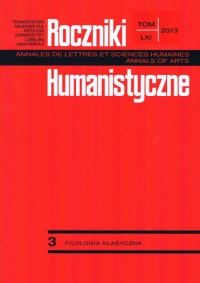Elements of the Mime in Horace’s Epode “Quid tibi vis, mulier”
Abstract
This article aims at discovering the literary context for Horace’s Epode 12 through juxtaposing it against Herondas’ mimes; in particular against Mime V, entitled Jealous. The description of the relationship that obtains between these works relies on the ancient theory of rhetoric and on elements of Ars poetica by Horace. The research helped determine that Epode 12 reveals numerous features that are characteristic of the mime: it is an apparent dialogue (sermocinatio) recited by a single performer (mime), most probably in a scenery of an ancient feast. A participant of the feast becomes an actor, who first performs the role of a male lover (iuvenis), and then he plays an elderly female lover (mulier). These protagonists are typical of old and new comedy styles. Nevertheless, the whole dramatic setting seems to bear the semblance of Mime V, in which the same literary protagonists can be found in the scene of a row between lovers. Specific rhetorical figures (imitatio) indicate, on the one hand, that the literary original was used in a creative manner. On the other, Mime V can also be used in the interpretation of Epode 12. This interpretation can be built on the processes of liberation and subjugation as part of the lovers’ relationship (actual subjugation in Mime V, and metaphorical - financial in Epode 12, where iuvenis is mulier’s “kept man”).
References
Acronis et Porphyrionis Commentarii in Q. Horatium Flaccum, ed. F. Havthal, Berolini 1864.
Barchiesi A.: Horace and Iambos: The Poet as Literary Historian, w: Iambic Ideas. Essays on a Poetic Tradition from Archaic Greece to the Late Roman Empire, ed. A. Cavarzere, A. Alo- ni, A. Barchiesi, Boston: Rowman and Littlefield Publishers, Inc. 2001, s. 141-164.
Brill’s Encyclopedia of the Ancient World, red. H. Cancik, H. Schneider, Leiden-Boston: Brill 2007.
Commager S.: The Odes of Horace, New Haven and London: Yale University Press 1963.
Czerwińska J.: Graus methuse - anus ebria, w: Fonctions de l’anecdote dans Les Œuvres Pharmaceutiques de Jean de Renou (1626), w: Le cabinet du curieux. Culture, savoirs, religion de l’Antiquité à l’Ancien Régime. Études et essais en l’honneur de Jean-Paul Pittion, éd. M. Kozluk, W.K. Pietrzak, Paris: Éditions Classiques Garnier 2012, s. 33-48.
Hanusiewicz M.: Pięć stopni miłości, Warszawa: Semper 2004.
Harrison S.J.: Some Generic Problems in Horace’s Epodes: Or, On (Not) Being Archilochus, w: Iambic Ideas. Essays on a Poetic Tradition from Archaic Greece to the Late Roman Empire, ed. A. Cavarzere, A. Aloni, A. Barchiesi, Boston: Rowman and Littlefield Publishers, Inc. 2001, s. 165-186.
Horatius Flaccus Q.: Dzieła wszystkie, oprac. O. Jurewicz, Wrocław: Ossolineum 1986.
Korus K.: Rzeczywistość w „mimach” Herondasa, „Meander” 9-10 (1994), s. 493-503.
Lausberg H.: Retoryka literacka. Podstawy wiedzy o literaturze, przeł./oprac. A. Gorzkowski, Bydgoszcz: Homini 2002.
Sielanka grecka, przeł. A. Swiderkówna, oprac. J. Łanowski, Wrocław: Zakład Narodowy im. Ossolińskich 1953.
Quinn K.: Horace, The Odes, Hong Kong: Nelson 1992.
Podręczny słownik terminów literackich, red. J. Sławiński, Warszawa: OPEN 199912.
Rostropowicz J.: Odbicie rzeczywistości politycznej, społecznej i gospodarczej w poezji aleksandryjskiej, Warszawa-Wrocław: PWN 1983.
Watson L.C.: Epode 14: Horace’s Carmen Inconditum?, w: Iambic Ideas. Essays on a Poetic Tradition from Archaic Greece to the Late Roman Empire, ed. A. Cavarzere, A. Aloni, A. Barchiesi, Boston: Rowman and Littlefield Publishers, Inc. 2001, s. 187-204.
Wilkinson L.P.: Horace and His Lyric poetry, Cambridge: Cambridge University Press 1968.
Wójcik A.: Talent i sztuka. Rzecz o poezji Horacego, Wrocław: Ossolineum 1986.
Zarzycka-Stańczak K.: Erotyki i sympotyki w drugim zbiorze Pieśni Horacego, „Rocz¬niki Humanistyczne” 23 (1975), z. 3, s. 59-72.
Zarzycka-Stańczak K.: Kilka uwag o Pieśniach Horacego, „Roczniki Humanistyczne” 16 (1968), z. 3, s. 93-106.
Zarzycka-Stańczak K.: Pieśni miłosne Horacego, „Roczniki Humanistyczne” 17 (1969) z. 3, s. 69-94.
Zarzycka-Stańczak K.: Problematyka literacka w Satyrach Horacego, „Roczniki Humanistyczne” 12 (1964), z. 3, s. 77-94.
Zarzycka-Stańczak K.: Rola aluzji i reminiscencji literackich w Satyrach Horacego, „Roczniki Humanistyczne” 9 (1960), z. 2, s. 55-66.
Copyright (c) 2013 Roczniki Humanistyczne

This work is licensed under a Creative Commons Attribution-NonCommercial-NoDerivatives 4.0 International License.





